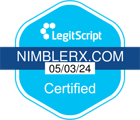


What is an EOB in Healthcare?
March 6, 2024
In the world of healthcare and pharmacies, there are a ton of acronyms. As a patient, it can be difficult to know what they all mean — and how they affect the way you get care and how much you pay for it.
One of those many acronyms specific to health insurance is ‘EOB’ and it’s crucial you understand what it means in the context of your insurance. So, let’s dive into what exactly an EOB is, how it differs from a bill, and what you should do when you get one.
What Does EOB Stand For?
An Explanation of Benefits, commonly known as an EOB, is a statement sent by your health insurance provider after you receive medical services or procedures.
It is not a bill, but rather a detailed explanation of how your healthcare claim was processed and what costs were covered. Insurance companies are often required by state law to send out an EOB within a certain content or format to you, the patient.
Nowadays, these often are sent via email or can be found within your insurance’s online portal — though it’s still very common to receive a paper copy of your EOB in the mail.
What’s Included in an EOB?
After listing which patient the EOB is for, there will be information about the billed service. You’ll see details about the healthcare provider who rendered the services, the date of service, and a description of the services provided.
Next, you’ll probably see a summary of the claim. The EOB will show:
- The amount of the total claim (or rather, the total amount billed for the appointment or service),
- How much your healthcare insurance plan covered,
- If your insurance negotiated for a lower payment or pricing,
- And finally, the remaining balance
The remaining balance is what you, the insured, are required to pay — this includes copayments, deductibles, and any coinsurance amounts. If there is an amount to pay you will receive a separate bill for these charges.
If An EOB Isn’t My Bill, Can I Toss It?
You should always open and thoroughly check your EOBs to make sure all the information is correct. Sometimes the wrong information gets billed and you may be charged more than you should.
Always check your EOB to:
- Ensure that your personal information and the provider's details are accurate
- Verify that the dates of service listed on the EOB correspond to the dates you received medical care
- Look at the total amount billed for the services
- Review the payments made by your insurance provider. This includes any adjustments or reductions in the billed amounts
- Pay close attention to the section that outlines your financial responsibility. This may include copayments, deductibles, and coinsurance
If you ever have questions or concerns about the information on your EOB, reach out to your insurance provider or healthcare professional for clarification. Remember, staying informed is an essential step toward taking control of your healthcare finances!


























.jpg)

















.jpg)


























.jpg)
.jpg)
.jpg)























.jpg)
.jpg)
.jpg)
.jpg)

